
Nuwara Eliya is a city in the hill country of the Central Province, Sri Lanka. Its name means "city on the plain " or "city of light". The city is the administrative capital of Nuwara Eliya District, with a picturesque landscape and temperate climate. It is at an altitude of 1,868 m (6,128 ft) and is considered to be the most important location for tea production in Sri Lanka. The city is overlooked by Pidurutalagala, the tallest mountain in Sri Lanka. Nuwara Eliya is known for its temperate, cool climate – the coolest area in Sri Lanka.
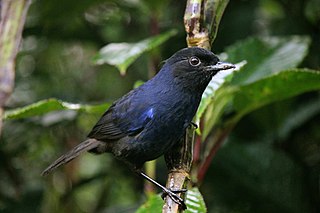
The Sri Lanka whistling thrush is a whistling thrush in the family Muscicapidae. It is a resident endemic bird in Sri Lanka.

Catharanthus is a genus of flowering plants in the family Apocynaceae. Like the genus Vinca, they are known commonly as periwinkles. There are eight known species. Seven are endemic to Madagascar, though one, C. roseus, is widely naturalized around the world. The eighth species, C. pusillus, is native to India and Sri Lanka. The name Catharanthus comes from the Greek for "pure flower".
Chirita was an Old World genus of the flowering plant family Gesneriaceae, native to Indo-Malaysia, S. E. Asia, and southern China. In 2011, the species in the genus were reassigned to several genera, with the type species assigned to the genus Henckelia, so that Chirita became a synonym, no longer recognized.

The ruddy mongoose is a mongoose species native to hill forests in India and Sri Lanka. This mongoose, along with the striped-neck and Indian grey mongeese, are the only mongoose species endemic to India and Sri Lanka. The ruddy mongoose is very closely related to Indian grey mongoose, but distinguished by its slightly larger size and black-tipped tail extending for 2 to 3 inches at the distal end. There are two subspecies of this mongoose, H. smithii smithii in India, and H. smithii zeylanicus in Sri Lanka.
Mus mayori is a species of rodent in the genus Mus, the mice. Its common names include Mayor's mouse, highland rat, and spiny mouse. It is endemic to Sri Lanka.
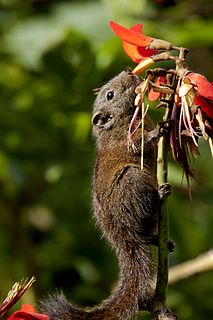
The Nilgiri striped squirrel is a threatened species of rodent, a small squirrel (Sciuridae) from rainforests in the southern Western Ghats, including the Nilgiris, in Peninsular India. It formerly included Funambulus obscurus from Sri Lanka as a subspecies, at which point the English name of the "combined species" also was dusky striped squirrel.
Wildlife of Sri Lanka includes its flora and fauna and their natural habitats. Sri Lanka has one of the highest rates of biological endemism in the world.
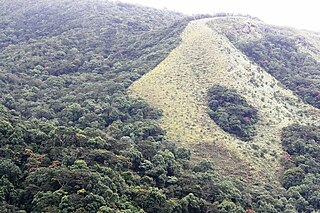
Hakgala Strict Nature Reserve is one of the three strict nature reserves in Sri Lanka, the only one in the wet zone. The reserve is an important although isolated cloud forest which supports a number of faunal species including some endemics. The area was designated a strict nature reserve on 25 February 1938. The reserve is adjacent to and contiguous with the Hakgala Botanical Garden which was founded in 1860.
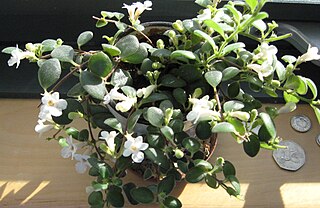
Codonanthe is a genus of mainly epiphytic plants in the family Gesneriaceae, endemic to the Atlantic Forest of Brazil. The botanical name comes from the Ancient Greek for 'bellflower'. They have white or pale pink flowers and somewhat fleshy leaves. In 2013, the genus was reduced in size when more than half of the species were transferred to Codonanthopsis. They can be grown as houseplants, particularly in hanging baskets. Artificial crosses with Nematanthus hybrids have produced the hybrid genus × Codonatanthus.
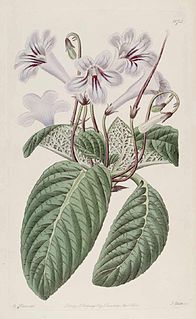
Streptocarpus rexii is a South African plant in the family Gesneriaceae, occurring widely from the southern Cape along the coastal hills, mountains, wooded ravines and valleys, and moist forests of the east coast, through Natal as far north as the Eastern Transvaal, up to an altitude of about 900 m. This genus of epiphytes and lithophytes, of about 130 species, is mainly African and Mascarene, with four vagrant species in Asia. Streptocarpus, as do other Old World Gesneriaceae, is unusual in that it displays anisocotylous or unequal growth, i.e. one cotyledon continues to grow after germination.

Seethawaka Botanical Garden, or Seethawaka Wet Zone Botanic Garden is a botanical garden located in Sri Lanka which mainly serves as a research area and a conservation area for threatened and vulnerable endemic plant species in the Sinharaja Rain Forest region. Improving export floriculture, ex-situ conservation of wet lowland plants, and bamboo cultivation are also promoted in this garden. The garden was opened to the public in late October 2014 and it is the most recently constructed botanical garden in Sri Lanka.
Alsophila walkerae, synonym Cyathea walkerae, is a species of tree fern endemic to Sri Lanka, where it grows in wetland forests.
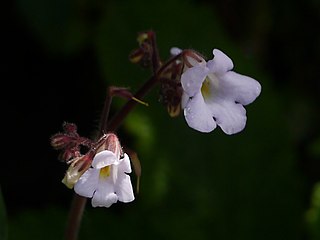
Henckelia is a genus of flowering plants in the family Gesneriaceae. Many of its species were formerly placed in Didymocarpus sect. Orthoboea and in the genus Chirita. Many species formerly placed in Henckelia have been moved to Codonoboea and Loxocarpus.
Malwattage Celestine Violet Savitri Gunatilleke is professor emeritus at the University of Peradeniya in Sri Lanka's Central Province. She has had a long career in forest ecology and has been a leader in quantitative ecology and education. Most of her research has focused in the Sinharaja rain forest in Sri Lanka. She considers her main contribution to forest ecology to be spreading the idea that successful forest conservation depends on local conservationists. In line with this, she is proud of her students and their accomplishments in the field of conservation.
Mary Mendum (1945-2004), born Caroline Mary Bates, was a British botanist, taxonomist and botanical illustrator. A number of plant species were described and named by her, as well as others named in memory of her. The Mary Mendum Medal is awarded in her honour for an exceptional outstanding botanical illustration.









